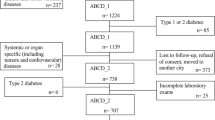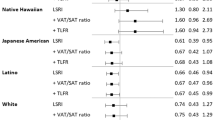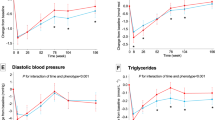Abstract
OBJECTIVE: To investigate whether insulin resistance modifies the rate of weight gain associated with a high percent of energy intake from dietary fat.
DESIGN: Longitudinal, observational population study.
SUBJECTS: A total of 782 nondiabetic Hispanic and non-Hispanic white free-living adult residents of the San Luis Valley in Colorado.
MEASUREMENTS: Subjects were seen up to three times over a 14-y period. Weight, height, fasting insulin and glucose, diet by 24 h recall, and self-reported physical activity were collected at each visit.
RESULTS: Percentage of energy intake from dietary fat was positively associated with weight gain over time (P=0.0103). High intake of dietary fat was more strongly related to weight gain in women than in men, and in those with lower total energy intake levels. The relationship between weight change and relative macronutrient intake also varied by baseline insulin sensitivity (P=0.0025). Weight gain over time in individuals with relative insulin resistance at baseline, as measured by QUICKI, was the greatest among those who consumed a higher percent of energy from fat.
CONCLUSION: Percentage of total intake from dietary fat predicts weight change independent of total energy intake. Nondiabetic, insulin-resistant individuals are particularly susceptible to the weight gain associated with high levels of dietary fat intake. Further investigation into the relationship between insulin resistance, diet, and weight gain is warranted.
This is a preview of subscription content, access via your institution
Access options
Subscribe to this journal
Receive 12 print issues and online access
$259.00 per year
only $21.58 per issue
Buy this article
- Purchase on Springer Link
- Instant access to full article PDF
Prices may be subject to local taxes which are calculated during checkout
Similar content being viewed by others
References
Flegal KM, Carroll MD, Ogden CL, Johnson CL . Prevalence and trends in obesity among US adults, 1999–2000. JAMA 2002; 288: 1723–1727.
Van Itallie TB . Health implications of overweight and obesity in the United States. Ann Intern Med 1985; 103: 983–988.
Stunkard AJ, Wadden TA . Obesity theory and therapy, 2nd edn Raven Press: New York; 1993. 2377pp (Chapter xiii).
Jonsson S, Hedblad B, Engstrom G, Nilsson P, Berglund G, Janzon L . Influence of obesity on cardiovascular risk. Twenty-three-year follow-up of 22,025 men from an urban Swedish population. Int J Obes Relat Metab Disord 2002; 26: 1046–1053.
Centers for Disease Control and Prevention (CDC). Behavioral Risk Factor Surveillance System Survey Data. US Department of Health and Human Services, Centers for Disease Control and Prevention: Atlanta, GA; 2000.
Golay A, Bobbioni E . The role of dietary fat in obesity. Int J Obes Relat Metab Disord: J Int Assoc Study Obes 1997; 21 (Suppl 3): S2–S11.
Bravata DM, Sanders L, Huang J, Krumholz HM, Olkin I, Gardner CD, Bravata DM . Efficacy and safety of low-carbohydrate diets: a systematic review. JAMA 2003; 289: 1837–1850.
Westman EC, Yancy WS, Edman JS, Tomlin KF, Perkins CE . Effect of 6-month adherence to a very low carbohydrate diet program. Am J Med 2002; 113: 30–36.
Vessby B, Karlstrom B, Ohrvall M, Jarvi A, Andersson A, Basu S . Diet, nutrition and diabetes mellitus. Ups J Med Sci 2000; 105: 151–160.
Lazarus R, Sparrow D, Weiss S . Temporal relations between obesity and insulin: longitudinal data from the Normative Aging Study. Am J Epidemiol 1998; 147: 173–179.
Porte Jr D, Seeley RJ, Woods SC, Baskin DG, Figlewicz DP, Schwartz MW . Obesity, diabetes and the central nervous system. Diabetologia 1998; 41: 863–881.
Eckel RH . Insulin resistance: an adaptation for weight maintenance. Lancet 1992; 340: 1452–1453.
Baba NH, Sawaya S, Torbay N, Habbal Z, Azar S, Hashim SA . High protein vs high carbohydrate hypoenergetic diet for the treatment of obese hyperinsulinemic subjects. Int J Obes Relat Metab Disord 1999; 23: 1202–1206.
Cornier MA, Donahoo W, Eckel RE, Hill JO, Draznin B . Insulin sensitivity determines the effectiveness of macronutrient composition of the diet on weight loss. J Invest Med 2003; 51: S383.
World Health Organization. Diabetes mellitus: Report of a WHO Study Group, Geneva. World Health Organization: Geneva; 1985. (Technical Report Series No. 727).
WHO Consultation Group. Definition, diagnosis and classification of diabetes mellitus and its complications, Part 1: Diagnosis and classification of diabetes mellitus. World Health Organisation: Geneva; 1999.
Beckman Instruments. Glucose analyzer 2 operating manual. Beckman Instruments: Fullerton, CA; 1988.
Matthews DR, Hosker JP, Rudenski AS, Naylor BA, Treacher DF, Turner RC . Homeostasis model assessment: insulin resistance and beta-cell function from fasting plasma glucose and insulin concentrations in man. Diabetologia 1985; 28: 412–419.
Katz A, Nambi SS, Mather K, Baron AD, Follmann DA, Sullivan G, Quon MJ . Quantitative insulin sensitivity check index: a simple, accurate method for assessing insulin sensitivity in humans. J Clin Endocrinol Metab 2000; 85: 2402–2410.
United States Bureau of the Census. 1980 Census of population. Vol 1. General population characteristics. Appendix B. US Government Printing Office: Washington, DC; 1983. (PC80-1-C7).
Marshall JA, Bessesen DH, Hamman RF . High saturated fat and low starch and fibre are associated with hyperinsulinaemia in a non-diabetic population: the San Luis Valley Diabetes Study. Diabetologia 1997; 40: 430–438.
Laird NM, Ware JH . Random-effects models for longitudinal data. Biometrics 1982; 38: 963–974.
Marshall JA, Scarbro S, Shetterly SM, Jones RH . Improving power with repeated measures: diet and serum lipids. Am J Clin Nutr 1998; 67: 934–939.
Hirsch J, Hudgins LC, Leibel RL, Rosenbaum M . Diet composition and energy balance in humans. Am J Clin Nutr 1998; 67: 551S–555S.
Rosenbaum M, Leibel RL, Hirsch J . Obesity. N Engl J Med 1997; 337: 396–407.
Levitsky DA . Putting behavior back into feeding behavior: a tribute to George Collier. Appetite 2002; 38: 143–148.
Rolls BJ . The role of energy density in the overconsumption of fat. J Nutr 2000; 130: 268S–271S.
Roberts SB, McCrory MA, Saltzman E . The influence of dietary composition on energy intake and body weight. J Am Coll Nutr 2002; 21: 140S–145S.
McCrory MA, Fuss PJ, Saltzman E, Roberts SB . Dietary determinants of energy intake and weight regulation in healthy adults. J Nutr 2000; 130: 276S–279S.
Flatt JP . Importance of nutrient balance in body weight regulation. Diabetes Metab Rev 1988; 4: 571–581.
Porte Jr D, Seeley RJ, Woods SC, Baskin DG, Figlewicz DP, Schwartz MW . Obesity, diabetes and the central nervous system. Diabetologia 1998; 41: 863–881.
Legato MJ . Gender-specific aspects of obesity. Int J Fertil Womens Med 1997; 42: 184–197.
Travers SH, Jeffers BW, Eckel RH . Insulin resistance during puberty and future fat accumulation. J Clin Endocrinol Metab 2002; 87: 3814–3818.
Hoag S, Marshall JA, Jones RH, Hamman RF . High fasting insulin levels associated with lower rates of weight gain in persons with normal glucose tolerance: the San Luis Valley Diabetes Study. Int J Obes Relat Metab Disord 1995; 19: 175–180.
Swinburn BA, Nyomba BL, Saad MF, Zurlo F, Raz I, Knowler WC, Lillioja S, Bogardus C, Ravussin E . Insulin resistance associated with lower rates of weight gain in Pima Indians. J Clin Invest 1991; 88: 168–173.
Wedick NM, Mayer-Davis EJ, Wingard DL, Addy CL, Barrett-Connor E . Insulin resistance precedes weight loss in adults without diabetes: the Rancho Bernardo Study. Am J Epidemiol 2001; 153: 1199–1205.
Lazarus R, Sparrow D, Weiss S . Temporal relations between obesity and insulin: longitudinal data from the Normative Aging Study. Am J Epidemiol 1998; 147: 173–179.
Hodge AM, Dowse GK, Alberti KG, Tuomilehto J, Gareeboo H, Zimmet PZ . Relationship of insulin resistance to weight gain in nondiabetic Asian Indian, Creole, and Chinese Mauritians. Mauritius Non-communicable Disease Study Group. Metabolism 1996; 45: 627–633.
Folsom AR, Vitelli LL, Lewis CE, Schreiner PJ, Watson RL, Wagenknecht LE . Is fasting insulin concentration inversely associated with rate of weight gain? Contrasting findings from the CARDIA and ARIC study cohorts. Int J Obes Relat Metab Disord 1998; 22: 48–54.
Marshall JA, Bessesen DH . Dietary fat and the development of type 2 diabetes. Diabetes Care 2002; 25: 620–622.
Lissner L, Heitmann BL, Bengtsson C . Population studies of diet and obesity. Br J Nutr 2000; 83: S21–S24.
Weber JL, Reid PM, Greaves KA, DeLany JP, Stanford VA, Going SB, Howell WH, Houtkooper LB . Validity of self-reported energy intake in lean and obese young women, using two nutrient databases, compared with total energy expenditure assessed by doubly labeled water. Eur J Clin Nutr 2001; 55: 940–950.
Trabulsi J, Schoeller DA . Evaluation of dietary assessment instruments against doubly labeled water, a biomarker of habitual energy intake. Am J Physiol Endocrinol Metab 2001; 281: E891–E899.
Goris AH, Westerterp-Plantenga MS, Westerterp KR . Undereating and underrecording of habitual food intake in obese men: selective underreporting of fat intake. Am J Clin Nutr 2000; 71: 130–134.
Hirvonen T, Mannisto S, Roos E, Pietinen P . Increasing prevalence of underreporting does not necessarily distort dietary surveys. Eur J Clin Nutr 1997; 51: 297–301.
Weinsier RL, Hunter GR, Desmond RA, Byrne NM, Zuckerman PA, Darnell BE . Free-living activity energy expenditure in women successful and unsuccessful at maintaining a normal body weight. Am J Clin Nutr 2002; 75: 499–504.
Wagner A, Simon C, Ducimetiere P, Montaye M, Bongard V, Yarnell J, Bingham A, Hedelin G, Amouyel P, Ferrieres J, Evans A, Arveiler D . Leisure-time physical activity and regular walking or cycling to work are associated with adiposity and 5 y weight gain in middle-aged men: the PRIME Study. Int J Obes Relat Metab Disord 2001; 25: 940–948.
Schmitz KH, Jacobs Jr DR, Leon AS, Schreiner PJ, Sternfeld B . Physical activity and body weight: associations over ten years in the CARDIA study. Coronary Artery Risk Development in Young Adults. Int J Obes Relat Metab Disord 2000; 24: 1475–1487.
Sherwood NE, Jeffery RW, French SA, Hannan PJ, Murray DM . Predictors of weight gain in the Pound of Prevention study. Int J Obes Relat Metab Disord 2000; 24: 395–403.
Smith SR, de Jonge L, Zachwieja JJ, Roy H, Nguyen T, Rood J, Windhauser M, Volaufova J, Bray GA . Concurrent physical activity increases fat oxidation during the shift to a high-fat diet. Am J Clin Nutr 2000; 72: 131–138.
Author information
Authors and Affiliations
Corresponding author
Rights and permissions
About this article
Cite this article
Mosca, C., Marshall, J., Grunwald, G. et al. Insulin resistance as a modifier of the relationship between dietary fat intake and weight gain. Int J Obes 28, 803–812 (2004). https://doi.org/10.1038/sj.ijo.0802621
Received:
Revised:
Accepted:
Published:
Issue Date:
DOI: https://doi.org/10.1038/sj.ijo.0802621



